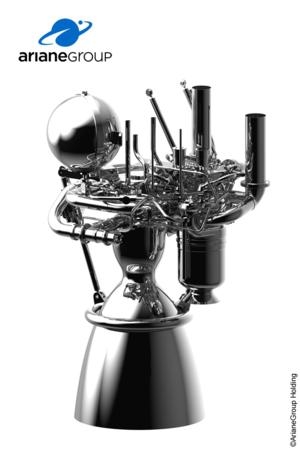Mon, Dec 25, 2017
Precursor For Future European Launch Engines
Prometheus is a European demonstrator for a very low cost reusable engine, running on liquid oxygen (LOx) and methane. It is the precursor for future European launcher engines as of 2030.

The aim is to be able to build future liquid propellant engines with a unit cost of about 1 million euros, or 10 times less than the cost of producing existing engines such as the Vulcain 2. The success of this type of technological challenge demands an entirely new approach and the use of innovative design and production methods and tools. Apart from switching from the traditional Ariane propellant (transition from the liquid oxygen and liquid hydrogen combination to a combination of liquid oxygen and methane), the demonstrator will entail major developments, including digitalization of engine control and diagnostics, and manufacturing using 3D printing in a connected factory environment.
The $88 million contract signed by Daniel Neuenschwander, Director of Space Transportation at the European Space Agency (ESA), and Alain Charmeau, CEO of ArianeGroup, the 50/50 joint-venture set up by the Airbus and Safran groups, covers the design, manufacturing and testing of the first two examples of the Prometheus demonstrator. The French space agency (CNES) is leading in the early design process, and testing is scheduled on the P5 test bed of the German Aerospace Centre (DLR) in Lampoldshausen, Germany, as of 2020.
"The development of Ariane 6 is on track, with a first flight scheduled for 2020. This new Prometheus contract with the European Space Agency is paving the way for the future of European launchers, with the goal of designing and building a reusable engine for one tenth the cost of today's Vulcain 2 type engines. I therefore thank ESA and the Member States for their contribution and their confidence in entrusting us with the development of the European technology of tomorrow."
Following the initial phase which was completed in early December, the first Program Review confirmed the consistency of the design choices with engine specifications and in particular with the recurring cost targets. At the same time, subsystems testing has started with the gas generator campaign (one of the parts built using 3D printing) on the DLR's P8 test bed in Lampoldshausen.
(Image provided with ArianeGroup news release)
More News
Also: New Lakeland Fly-in!, Gleim's DPE, MOSAIC! Nearly three-quarters of a century in the making, EAA is excited about the future… especially with the potential of a MOSAIC>[...]
Estimated (EST) -When used in NOTAMs “EST” is a contraction that is used by the issuing authority only when the condition is expected to return to service prior to the >[...]
Aero Linx: Regional Airline Association (RAA) Regional airlines provide critical links connecting communities throughout North America to the national and international air transpo>[...]
The Airplane Broke Up In Flight And Descended To The Ground. The Debris Path Extended For About 1,435 Ft. Analysis: The pilot, who was the owner and builder of the experimental, am>[...]
From 2015 (YouTube version): History Comes Alive Thanks to A Magnificent CAF Effort The story of the Douglas C-47 named, “That’s all Brother,” is fascinating from>[...]
 Airborne 07.21.25: Nighthawk!, Hartzell Expands, Deltahawk 350HP!
Airborne 07.21.25: Nighthawk!, Hartzell Expands, Deltahawk 350HP! ANN's Daily Aero-Term (07.27.25): Estimated (EST)
ANN's Daily Aero-Term (07.27.25): Estimated (EST) ANN's Daily Aero-Linx (07.27.25)
ANN's Daily Aero-Linx (07.27.25) NTSB Final Report: Luce Buttercup
NTSB Final Report: Luce Buttercup Classic Aero-TV: 'That's All Brother'-Restoring a True Piece of Military History
Classic Aero-TV: 'That's All Brother'-Restoring a True Piece of Military History



